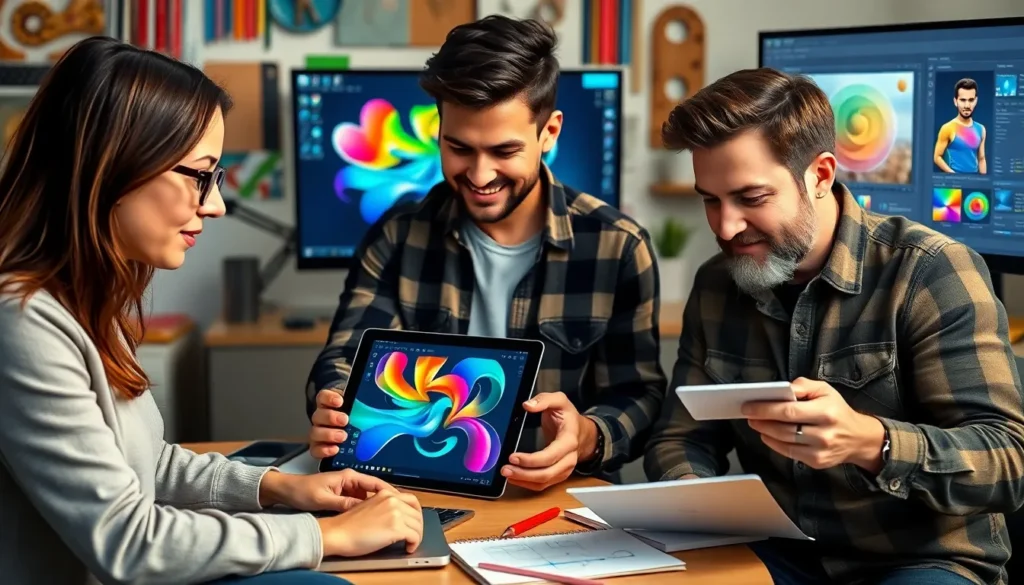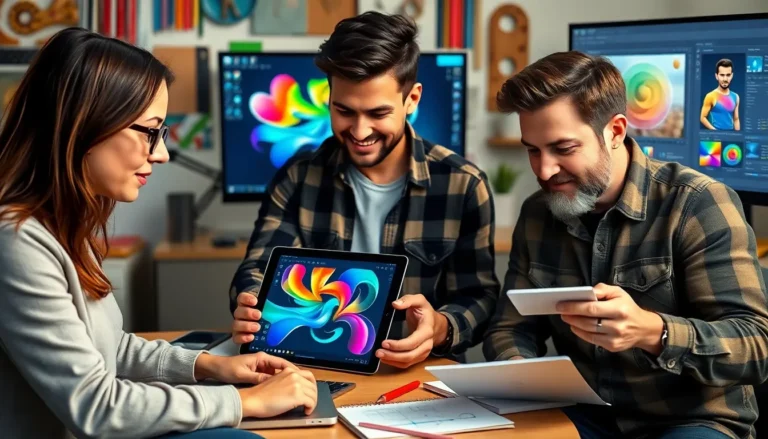In today’s visually-driven world, digital cover creation has become an essential skill for marketers, authors, and content creators alike. A captivating cover not only grabs attention but also conveys the essence of the content within. With the rise of online platforms, the demand for striking and professional designs has skyrocketed, making it crucial to understand the art and science behind effective cover creation.
From eBooks to social media graphics, the principles of design play a pivotal role in attracting audiences. Whether one is a seasoned designer or a novice, mastering digital cover creation can elevate any project and enhance its marketability. This article dives into the key elements and tools that make digital cover creation both accessible and impactful.
Table of Contents
ToggleOverview of Digital Cover Creation
Digital cover creation plays a vital role in capturing audience attention in a visually-driven marketplace. Marketers, authors, and content creators must understand its importance to effectively represent their work.
Importance of Digital Covers
Digital covers serve as a first impression for products and content. Eye-catching designs convey professionalism and quality, influencing consumer perception. According to a study by the Nielsen Norman Group, 94% of first impressions relate to design elements, emphasizing the necessity for appealing covers. Engaging covers not only attract views but also enhance brand recognition, leading to increased sales and audience trust.
Types of Digital Covers
Several types of digital covers cater to different media and platforms:
- Ebook Covers: Ebooks require compelling designs that communicate the genre and theme, encouraging potential readers to click and purchase.
- Music Album Covers: For music, covers reflect the artist’s identity and genre, contributing to a cohesive branding strategy.
- Social Media Covers: Platforms like Facebook and YouTube utilize cover images to create impactful profiles, increasing follower engagement.
- Podcast Covers: Podcast covers need to represent the show’s theme and tone, aiding in discovery through visual appeal.
- Magazine Covers: Magazines should combine attention-grabbing headlines and images to entice readers in print and digital formats.
Understanding these types aids in selecting the right approach for effective digital cover creation.
Tools for Digital Cover Creation

Various tools enhance the process of digital cover creation, catering to different skill levels and requirements. Utilizing the right software or platform facilitates the design of eye-catching and professional covers.
Graphic Design Software
Graphic design software provides robust features for creating digital covers. Popular software options include:
- Adobe Photoshop: Known for its advanced photo editing capabilities, Photoshop enables users to manipulate images and create intricate designs.
- Adobe Illustrator: This vector graphics editor excels in creating logos and illustrations, ideal for scalable cover designs.
- CorelDRAW: An alternative to Illustrator, CorelDRAW simplifies vector graphic design, catering to both beginners and professionals.
- Affinity Designer: Offering a one-time purchase model, Affinity Designer provides powerful design tools for tailored cover creation.
These software options cater to varying experience levels, from beginners to seasoned designers, ensuring flexibility in design approaches.
Online Platforms
Online platforms make digital cover creation accessible for all users. Notable platforms include:
- Canva: A user-friendly interface with templates for various cover types, Canva offers drag-and-drop features suitable for beginners.
- Visme: Known for its presentation capabilities, Visme provides cover templates and customization features, streamlining the design process.
- BookCoverZone: Specializing in ebook covers, BookCoverZone allows users to browse and customize pre-made templates for quick results.
- Placeit: This tool focuses on mockups and templates, allowing users to create visually appealing designs with minimal effort.
These online platforms often eliminate the need for complex software, allowing users to create professional-quality covers quickly.
Tips for Effective Digital Cover Creation
Effective digital cover creation hinges on thoughtful design choices. The right elements can significantly enhance visual appeal and audience engagement.
Choosing the Right Fonts
Selecting appropriate fonts strengthens the overall impact of a digital cover. Prioritize legibility alongside style to ensure messages are clear. Consider these factors when choosing fonts:
- Readability: Opt for fonts that are easy to read at various sizes. Avoid overly decorative options for titles or critical text.
- Consistency: Maintain uniformity across covers. Use no more than two to three different fonts to create a cohesive look.
- Hierarchy: Differentiate between headings, subheadings, and body text. Use larger, bolder fonts for titles to draw attention and smaller fonts for descriptive text.
- Contrast: Ensure adequate contrast with the background. Light text on dark backgrounds or vice versa improves visibility.
Utilizing Colors and Imagery
- Color Scheme: Choose a color palette that aligns with the content’s tone. Utilize color psychology to evoke desired feelings; for example, blue conveys trust while red signifies excitement.
- Imagery Quality: Use high-resolution images for clarity and professionalism. Blurry or pixelated visuals diminish overall quality.
- Relevance: Select images that reflect the subject matter. Ensure they enhance understanding and aren’t merely decorative.
- Branding: Incorporate brand colors or logos to reinforce identity. Consistent use across various covers builds recognition and trust.
Trends in Digital Cover Creation
Current trends in digital cover creation reflect the evolving preferences of audiences and advancements in design technology. Understanding these trends helps creators connect better with their target markets and stay relevant.
Minimalist Designs
Minimalist designs emphasize simplicity and clarity, using limited elements to convey a message effectively. These designs typically feature ample white space, a restrained color palette, and a focus on typography. Popular among ebook covers and social media graphics, minimalist designs often resonate well with modern audiences, who appreciate clean aesthetics. By prioritizing essential components, designers draw attention to key messages or images, fostering greater engagement while maintaining an uncluttered appearance.
Interactive Covers
Interactive covers leverage technology to engage audiences dynamically. These covers often incorporate animated elements, sound effects, or augmented reality features, providing an immersive experience. Common in digital magazines and interactive ebooks, interactive covers can captivate users’ interest and enhance the storytelling aspect. Platforms like Adobe Spark and Artivive facilitate the creation of such covers, allowing designers to push creative boundaries. Though they require more planning and technical know-how, the potential for audience interaction makes them a compelling trend in digital cover creation.
Digital cover creation is more than just a visual element; it’s a vital component of effective marketing and branding. By understanding design principles and utilizing the right tools, creators can craft covers that not only stand out but also resonate with their audience.
As trends evolve and technology advances, staying updated with the latest design strategies ensures that covers remain relevant and engaging. Whether through minimalist aesthetics or interactive features, the right cover can significantly impact audience perception and drive success. Embracing these insights can empower creators to elevate their projects and connect meaningfully with their target markets.




